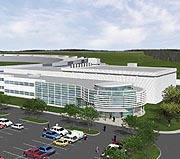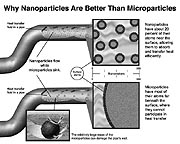Home > Press > Nanomaterials break out of laboratory into marketplace
Abstract:
Miniature medical machines that can bring sight to the blind and computers that work at the speed of light are no longer the stuff of futuristic novels. Argonne National Laboratory researchers are creating nanomaterials and nanotechnology to make these and other innovations possible, and collaborating with industry to bring new technologies to the marketplace.
Nanomaterials break out of laboratory into marketplace
Argonne, Ill.
Miniature medical machines that can bring sight to the blind and computers that work at the speed of light are no longer the stuff of futuristic novels. Argonne National Laboratory researchers are creating nanomaterials and nanotechnology to make these and other innovations possible, and collaborating with industry to bring new technologies to the marketplace.
Nanomaterials have been under study at Argonne since the 1980s. Built from the bottom up with particles just a few atoms across and measured in the billionths of a meter, these materials exhibit unique electronic, magnetic, structural, chemical and optical properties. Accordingly, nanoscience and nanotechnology are among the hottest areas of research internationally and are potentially a trillion dollar industry.
Nanotechnology is expected to open new possibilities in areas as diverse as superconductivity, computer memory media, electrical and thermal transmission, micro-switching devices and highly sensitive free-radical detectors.
“Argonne is a natural research center for nanoscience,” said Center for Nanoscale Materials Director Eric Isaacs. The laboratory's strong materials sciences program provides decades of expertise in producing these materials.

DIAMONDS FOR EYES – Argonne material scientists Orlando Auciello (right) and John A. Carlisle work with a new microwave plasma system that grows the diamond films used in artificial retina research. Courtesy and © Copyright ANL. |
The traditional distinctions among scientific disciplines blur at the nanoscale, and Argonne's multidisciplinary staff excels in developing cross-disciplinary approaches to problem-solving. Biologists, chemists, physicists, materials scientists and other researchers collaborate on basic research. Later, they collaborate with industry to combine market needs and innovative science, and transfer research results to the marketplace.
Argonne has partnered with many large and small companies interested in nanomaterials. Some companies are formed expressly to license laboratory technology. Nanophase Technologies Corp. is an early example of Argonne's work with industry. The publicly traded company was founded in the 1980s to commercialize an Argonne technology for making materials from particles less than 50 nanometers in diameter.
Nanophase's challenge was to commercialize the nanomaterials synthesis process by bringing production volume up and cost down. Initially, materials production was measured in grams per day and cost thousands of dollars per gram. Now, production is measured in tons, and the cost is low enough that the company's materials are used in personal products, textile fibers, fuel cells and abrasion-resistant coatings.
Advanced Diamond Technologies is the latest company developed to license Argonne-developed nanomaterials technology. The company licensed the rights to Argonne's ultrananocrystalline diamond (UNCD) patents and is developing protective UNCD coatings for several applications, including mechanical shaft seals used in many industries. Reducing friction with UNCD coatings can help devices last longer and run cooler.
The company is using UNCD as a substrate for building Micro-Electro-Mechanical Systems (MEMS) – systems-on-a-chip technology that integrates mechanical elements, sensors, actuators and electronics on a common substrate – and for biomedical implants and biosensors.
Argonne research with industry
Argonne's UNCD films may help to restore sight to the millions of people who have degenerative retinal disease. The UNCD film hermetically seals a silicon microchip implanted in the eye's corrosive environment. Researchers are working with Second Sight Medical Products, Inc., and six other research organizations to refine a device to replace the eye's destroyed rods and cones as light receptors and optical signal converters.
Argonne scientists developed a patented method to suspend copper nanoparticles in water and ethylene glycol. The resulting heat-transfer fluids conduct heat more efficiently than conventional coolants because the suspended nanoscale particles have a higher percentage of their atoms near their surfaces, improving the fluid's ability to absorb and transfer heat. The particles' small mass does not damage heat exchange surfaces. Argonne is working with NEI Corp., Nuvonyx, Inc., and the Korean Electric Power Research Institute to refine this technology for practical use.
Argonne chemists have developed a technique to join nanoparticles of the metal oxide titanium dioxide with DNA to produce novel bio-inorganic hybrids. These coated semiconductor nanoparticles can be programmed to seek out a specific cell type, attach to the cell surface and carry out spatially confined chemistry. Researchers performed early work in this area sponsored by DOE's Basic Energy Sciences, Chemical Sciences program. They are now developing this technology to carry out photodynamic therapy with a company that has a Small Business Innovation Research grant funded by the National Institutes of Health.
Applications could range from biomolecular semiconductors for energy conversion in photosynthesis, photodynamic medical therapy, biosensors, nanomachines, cell manipulators and molecular scissors.
Other nanotechnology research
A system to clean porous structures such as brick and concrete contaminated by radioactive materials uses engineered nanoparticles combined with a super absorbent gel similar to that found in a baby diaper. In the event of a terrorist attack with a “dirty bomb” or other radioactive dispersal devices, the system would allow porous structures that trap radioactive materials to be cleaned instead of demolished. The method was demonstrated in May 2004 for the Department of Homeland Security. These researchers are also developing this technology for biomedical and military applications.
Nanomagnetism combines materials in novel ways to produce nanoscale magnetic storage systems. One such technology under study at Argonne, spintronics, can help revolutionize computing capabilities by providing denser, more reliable data storage enabling faster computer startups and more energy-efficient systems.
Microscopic-sized optical circuits and switches may flow out of chemical research to understand the unusual optical properties of metal nanoparticles. Metal nanoparticles can concentrate large amounts of light energy at their surfaces and may be key to one day replacing electrons in computers with the faster-moving photons that give off less heat and friction.
Research facilities
Argonne's nanoscience research has a new home in the Center for Nanoscale Materials (CNM), a Department of Energy research and user facility sited at the laboratory to foster collaboration between academia, industry and other government laboratories.

NANOHOME – A new building to house the Center for Nanoscale Materials is under construction at Argonne. Courtesy and © Copyright ANL. Click to enlarge. |
“Argonne is an ideal site for the CNM,” Isaacs said, “because this is the only place in the country where you can find hard X-rays at the Advanced Photon Source (APS), neutrons at the Intense Pulsed Neutron Source and an Electron Microscopy Center— three powerful and complementary tools for nanoresearch in one laboratory.” These facilities are open to academic, government and industrial users through a peer-reviewed process.
A new building to house the Center for Nanoscale Materials is under construction. It will provide research instruments, laboratories, clean rooms and work space to assist in fabricating and understanding these tiny materials.
CNM's first dedicated instrument will be the pioneering nanoprobe beam line under construction at the APS, this hemisphere's most brilliant source of X-rays for research. The nanoprobe will be a hard X-ray microscopy beamline with the highest spatial resolution in the world. With its combination of fluorescence, diffraction and transmission imaging at a spatial resolution of 30 nanometers or better in a single tool, the nanoprobe will be able to penetrate samples in situ and provide information about their internal structures.
An electron-beam lithography facility will provide fabrication support to CNM users, including a 100-kilovolt electron-beam lithography device – one of a handful of such devices in the country. The center will also feature an Argonne-developed nanopositioning system for precision motion and measurement.
Argonne's CNM research examines the behavior and fundamental properties of nanomaterials with a special emphasis on:
- Theory and simulation
- Lithography
- Nanoprobe
- Nanomagnetism
- Bio-inorganic interface
- Nanocarbon
- Complex oxides
- Nanophotonics
- Reimbursable research and development
- Cost-shared research and development
- Technical services
- Licensing
- Nondisclosure agreements
- Personnel exchanges
- Access to Argonne's scientific and technical facilities
Writer: Evelyn Brown Media contact:
Catherine Foster
630/252-5580
cfoster@anl.gov
Scientific contacts:
- UNCD: John Carlisle carlisle@anl.gov
- Heat Transfer: Steve Choi choi@anl.gov
- Bio-inorganic Hybrids: Tijana Rajh rajh@anl.gov
- Cleaning Porous Materials: Michael Kaminski kaminski@cmt.anl.gov
- Nanomagnetism: Sam Bader bader@anl.gov
- Center for Nanoscale Materials : Eric Isaacs isaacs@anl.gov
- Technology Transfer: Cindy Wesolowski weso@anl.gov
If you have a comment, please us.
Issuers of news releases, not 7th Wave, Inc. or Nanotechnology Now, are solely responsible for the accuracy of the content.
| Related Links |
![]() Second Sight Medical Products, Inc.
Second Sight Medical Products, Inc.
![]() Center for Nanoscale Materials (CNM)
Center for Nanoscale Materials (CNM)
| Related News Press |
Possible Futures
![]() Nanotechnology: Flexible biosensors with modular design November 8th, 2024
Nanotechnology: Flexible biosensors with modular design November 8th, 2024
![]() Exosomes: A potential biomarker and therapeutic target in diabetic cardiomyopathy November 8th, 2024
Exosomes: A potential biomarker and therapeutic target in diabetic cardiomyopathy November 8th, 2024
![]() Turning up the signal November 8th, 2024
Turning up the signal November 8th, 2024
![]() Nanofibrous metal oxide semiconductor for sensory face November 8th, 2024
Nanofibrous metal oxide semiconductor for sensory face November 8th, 2024
Nanomedicine
![]() Exosomes: A potential biomarker and therapeutic target in diabetic cardiomyopathy November 8th, 2024
Exosomes: A potential biomarker and therapeutic target in diabetic cardiomyopathy November 8th, 2024
![]() Unveiling the power of hot carriers in plasmonic nanostructures August 16th, 2024
Unveiling the power of hot carriers in plasmonic nanostructures August 16th, 2024
Materials/Metamaterials/Magnetoresistance
![]() Nanoscale CL thermometry with lanthanide-doped heavy-metal oxide in TEM March 8th, 2024
Nanoscale CL thermometry with lanthanide-doped heavy-metal oxide in TEM March 8th, 2024
![]() Focused ion beam technology: A single tool for a wide range of applications January 12th, 2024
Focused ion beam technology: A single tool for a wide range of applications January 12th, 2024
Profiles
![]() Russia’s Nano-enabled Products Market to Witness Massive Growth February 8th, 2011
Russia’s Nano-enabled Products Market to Witness Massive Growth February 8th, 2011
![]() Adept Technology Announces Orders for Over $600K from Chinese Partner January 18th, 2011
Adept Technology Announces Orders for Over $600K from Chinese Partner January 18th, 2011
![]() Nanostart-held ItN Nanovation Receives Major Follow-on Order in Saudi Arabia November 29th, 2010
Nanostart-held ItN Nanovation Receives Major Follow-on Order in Saudi Arabia November 29th, 2010
![]() Homegrown Companies Developing Batteries for Clean Energy Storage November 2nd, 2010
Homegrown Companies Developing Batteries for Clean Energy Storage November 2nd, 2010
|
|
||
|
|
||
| The latest news from around the world, FREE | ||
|
|
||
|
|
||
| Premium Products | ||
|
|
||
|
Only the news you want to read!
Learn More |
||
|
|
||
|
Full-service, expert consulting
Learn More |
||
|
|
||









